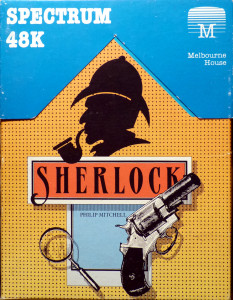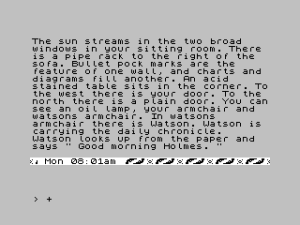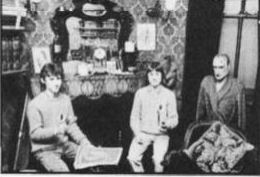The most anticipated British adventure release of 1984 was Melbourne House’s followup to The Hobbit, that perennial bestseller that remained one of the top two games in the country for much of the first two years after its release. Indeed, Melbourne House, who opened a splashy new office in Richmond, England, early in 1984 and was now established as one of the most important publishers in the British market, could be described without hyperbole as the house that The Hobbit had built. Everyone was dying to see their next big adventure.
The most logical candidate for a Hobbit followup must be the sequel to the source material of that work: The Lord of the Rings. When Alfred Milgrom of Melbourne House approached the Tolkien estate, however, he learned that it was not available. All media rights had been leased in the 1970s, before anyone knew what computer games were, to Fantasy Films, who had produced an animated film version of the first half of the story in 1978. That had been a flop (how times do change…), with the result that funding was never secured to complete the story. Still, Fantasy’s lease had yet to expire even though they were doing absolutely nothing with it. Milgrom, who believed — probably correctly — that being based on such an iconic property had been a major contributor to The Hobbit‘s success, looked around for something similarly iconic to adopt. He found it in Arthur Conan Doyle’s Sherlock Holmes stories, which had the added virtue of being out of copyright. Melbourne House’s Hobbit “sequel” would be a new case for the timeless sleuth and his partner Watson.
Thus early in 1983 Philip Mitchell, now elevated to Melbourne House’s lead adventure developer in the wake of Veronika Megler’s departure, started work on Sherlock, building upon the adventure engine he and Megler had developed for The Hobbit. The core idea remained the same: to create a living world populated by other characters going about their business and pursuing their own goals, full of dynamism and emergent elements. Throw in the complications of an intricate mystery plot rather than a simple quest narrative, and it became one hell of a tall order. Throw in the need to have it all reside, with graphics, in 48 K of memory, and it started to look impossible. Confidently expected at first in a matter of a handful of months, the release date was pushed back to February of 1984, then to perhaps May or June, finally to September, while Mitchell wrestled with the challenge in two-steps-forward-one-step-back fashion (or sometimes vice versa). The game finally appeared after some eighteen months of development, a crazily long amount of time to work full time on an adventure game by the standards of the early 1980s; Level 9’s Pete Austin, by way of comparison, cranked out four big adventures in the same period while also helping to run a company. Sherlock‘s belated arrival was greeted as a major event. It simply had to be something special.
And that it certainly was — albeit perhaps not quite in the way anticipated. Sherlock starts with all the weirdness of The Hobbit and then multiplies it by ten. The game seems to have a life of its own, to have gotten away not only from you but also from Mitchell. To play is to step into a bizarrely addled world where nothing quite works the way it ought to. It starts with the opening text, which reads like it was written by a Victorian difference engine with a poor grasp of English grammar.
Melbourne House described Sherlock thus:
In Sherlock, you take on the role of Holmes. With the ever-faithful Watson you will roam freely through the gaslit streets of London and explore Victorian England in your quest to disentangle seemingly inexplicable and unresolvable mysteries. You will follow up clues and confront sinister and elusive characters during your adventure.
In reality, the game has nary a shred of the verisimilitude that description would suggest, although the adjectives “inexplicable” and “unresolvable” can certainly be applied in other ways. Once again the characters are just intelligent enough to seem unbelievably stupid. Sherlock‘s most loathed character, its equivalent of The Hobbit‘s Thorin, became Watson, whom you can never quite get to do what you want him to. Watson’s infuriating equivalent of Thorin’s singing about gold is to tell you over and over, apropos of nothing, what brilliant deductions you’re making.
And then there are the outright bugs. Oh, boy, what bugs. These are bugs for the ages. The strange behaviors that emerge from them can be counter-intuitively inspiring. The magazines soon latched onto “SherlockBugs” as a compound name for an entire genre of letters and articles to go along with the earlier “HobbitBugs”; many players found them the most interesting part of the game. In Sherlock, unconscious characters can talk.
You can see an unconscious policeman. An unconscious policeman says " I'm sorry, sir, I have my orders, but no one is to get by. "
SherlockBugs were soon being divided into subgenres to cope with their sheer quantity. One of the most populated of these involved all the strange interactions that swirl around the cab that you and the other characters use to travel around London. A letter writer to Personal Computing Weekly was amongst the first to note that all was not quite right with the cab.
I had been searching for some time for Major Percival Foulkes when, on returning to Baker Street, I found him in a hansom cab in my hall! I have since tried to remove him and the cab from the hall without success.
Now the game was afoot to see just how weird things could get.
Take the cab to Kings Cross Road, get out, and tell the cabbie to follow you. Go to the nearest train and tell the cabbie to climb into it. Then return to the cab, climb in, and type “LOOK.”
After trying this out, my inventory read: “You are carrying your alibi, herself, innocent, the Old Mill Road, guilty, and an idiot!”
Some players learned how to make the bugs work for them. A big problem for many was Inspector Lestrade, who takes off on the wrong track entirely as usual and will close the case by arresting the wrong person when the game has barely begun unless you can find some way to convince him otherwise — which is not terribly easy to do. One Ian Eaton of Hednesford found an alternative approach: to stash him in a cab.
When returning from Leatherhead on Monday night, follow Lestrade from the train and onto Kings Cross Road. Now as soon he hails a cab input “SAY TO CABBIE, GO TO ALDERGATE STREET.” You then realize that Lestrade has climbed into the cab and has been whisked off before he can give the cabbie his destination. I’ve found if you catch a cab yourself to Aldergate Street you find Lestrade sitting in the first cab, waiting patiently out of the way.
This enables the novice to explore London in peace, unhindered, and collect clues.
Other bugs were less useful. Players eventually figured out that replying to Watson’s “Good morning” at the beginning of the game with an innocent “Hello” would cause the game to crash many turns later — as would, incredibly, just talking too much in general to him. Melbourne House themselves, who resolutely spun all bugs as features resulting from the game’s “sophistication,” had this to say about that situation:
Watson is the one character who learns during the game and because his character consumes so much memory, you should be aware of not talking to him too much, or his knowledge could completely fill all available space and give you an “out of memory” statement.
Yes, the poor fellow can become just too smart for his own good — or yours.
Even when it’s working correctly the game is problematic. Much of the problem is the parser, which, for all that Melbourne House loved to hype its “Inglish” grammar, leaves much to be desired. It accepts one and only one idiosyncratic phrasing for most actions. (You can’t “ENTER,” “GET IN,” “GET INTO,” or “CLIMB IN” a vehicle, only “CLIMB INTO” it.) Glossy magazine reviewers generally gave the game the expected stellar grade, but even they couldn’t hold back from chiming in with some complaints. Crash magazine called the parser “clinical” and the game “too big for its boots.” Computer and Video Games called the parser “torturous” and summarized the game as “an intriguing and absorbing game written for the wrong machine by someone who doesn’t speak the vernacular.”
Between the bugs, the parser frustrations, and the need to be in the right place at the right time and manipulate all of the other characters just so, Sherlock is a well-nigh impossible game to actually solve. Melbourne House encouraged early players to contact them after solving the game, not through a formal contest of the sort favored by many British publishers but nevertheless with a certain unspoken promise of reward and recognition for the first to successfully manage the feat. It took the nation more than four months to produce a winning team. That was David and Paul Cunningham, a pair of teenage brothers from the village of Morpeth in Northumberland. Paula Byrne, Melbourne House’s British publicity manager, took the boys to lunch at The Sherlock Holmes Restaurant, where they got to explore Sherlock’s normally glassed-off study and also got the expected bag of Melbourne House swag. Incredibly, the brothers claimed to have played only on the weekends: “We weren’t allowed to play it during the week because of our homework!”
Sherlock is by no stretch a good game, but all its craziness certainly makes it one of the most entertaining bad games I’ve ever played. It’s so out of control, so completely off the rails, that you half expect it to find a way to climb right out of your computer and start taking over the world. It’s kind of a fascinating experience, even today. (If you’d like to see for yourself, feel free to download its Spectrum incarnation.) In its day, the game was a hit beyond even Melbourne House’s expectations, selling out its first production run in three days and leaving the company scrambling to make more to feed Christmas demand. While it wouldn’t ultimately have the legs that The Hobbit did, it did more than well enough to encourage Melbourne House to keep at their anarchic and oddly compelling take on the adventure game.
Shortly before Sherlock‘s release, Fantasy Films’s lease on The Lord of the Rings expired at last, and Milgrom was able to scoop up the gaming rights. Mitchell proceeded to lead development over the rest of the decade of three more adventures based on the trilogy. All emerged with the same collection of bugs and unanticipated emergent behaviors that had become Melbourne House’s trademark. By now, however, gamers were becoming more discerning and the oddities somehow less charming. People at last started asking why Melbourne House couldn’t seem to hire a QA team, and why they were paying good money for sub-alpha-quality software. Each new game sold fewer copies than the last, and when The Crack of Doom appeared to end Melbourne House and Philip Mitchell’s career in text adventures it attracted barely a whisper of attention. Thus died quietly a unique — if also uniquely problematic — approach to interactive fiction.
(Quite a lot of minor sources this time for such a short article. I’ll run through them quickly: Popular Computing Weekly of October 6 1983, October 27 1983, July 5 1984, November 8 1984, and January 17 1985; Micro Adventurer of November 1983 and November 1984; Personal Computer Games of February 1984, November 1984, and December 1984; Crash of April 1984, June 1984, October 1984, December 1984, and September 1985; Home Computing Weekly of September 25 1984 and March 5 1985; Computer and Video Games of November 1984, April 1985, and September 1985. The photo of the Cunningham brothers was taken from the April 1985 Computer and Video Games.)










